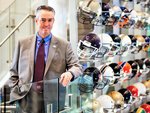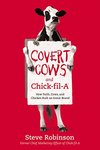FOLEY — In today’s world, it’s hard to think about Chick-fil-A without thinking about cows. For that matter, it’s hard to think about cows without thinking about Chick-fil-A.
In his new …
This item is available in full to subscribers.
Please log in to continue |


FOLEY — In today’s world, it’s hard to think about Chick-fil-A without thinking about cows. For that matter, it’s hard to think about cows without thinking about Chick-fil-A.
In his new book, “Covert Cows and Chick-fil-A: How Faith, Cows and Chicken Built an Iconic Brand,” former chief marketing officer and Foley native Steve Robinson talks about working with the ad agency to create the iconic brand whose mere mention brings a smile to most everybody’s face.
Just mentioning it gets a chuckle from Robinson.
“We really didn’t need traditional marketing until the mid-90s,” Robinson said. “Until then our marketing started with our Operators and went from there.”
Robinson not only talks about building the iconic brand through the “Eat Mor Chikin” (which actually started out as “Eat Mor Chickin” but the “c” was dropped presumably because it wouldn’t fit on the sign) campaign, he delves into the story of Chick-fil-A founder Truett Cathy, who started with one restaurant in the 1940’s called The Dwarf Grill.
“I wrote this book mainly for the Chick-fil-A family,” said Robinson, who came on board as marketing director in 1981 where he stayed for 34 years before retiring in 2015. “As the business has gotten bigger I realized that there were more and more employees in the Chick-fil-A family who simply didn’t know the story of how we got started and how we grew to be where we are today.”
Along with building the business through faith, Robinson talks about the evolution of the brand and taking the marketing strategy from the ground up and leaving a lasting legacy for years to come.
He also talks about his own roots, growing up in Foley and working alongside his father, who started out as a farmer, then later built an agriculture-related business.
“My father was a member of the greatest generation,” Robinson said. “By spending time with him, not on fishing trips or family vacations, but working for and alongside him, he taught me the value of hard work.”
Robinson also talks about his other early influences, primarily coaches like Ivan Jones, Lester Smith and Denzel Hollis, while playing baseball and basketball for Foley High School.
“Like my father, these men were men of faith and men who believed in hard work,” Robinson said. “I was not only fortunate to have them in my life, but also a circle of friends that, thanks in part to modern social media, I still remain in contact with today.”
Another leap of faith, Robinson said, was the opportunity to study abroad through the American Field Service exchange program in New Zealand.
“That was something I would not have chose to do on my own,” he said. “But thanks to teachers at Foley who encouraged me to take a leap of faith, it is something that would shape my future.”
When he returned, Robinson said, he had a choice to follow in his father’s footsteps, but it was after an encounter with a minister in Mobile that Robinson decided to take another leap of faith by finding his own path in the marketing industry.
After high school, Robinson attended Faulkner State Junior College (now Coastal Alabama Community College), then Auburn University before beginning his career at Texas Instruments. He would later earn positions at Six Flags in Texas and Florida before a former connection led him into the Chick-fil-A family in 1981.
From a brief encounter in 1978 to a hiring process that took five and a half months, Robinson said he soon realized that he had walked into a different environment at Chick-fil-A, where treating people with respect and doing things the right way were more important than the bottom line.
“It was made clear from the beginning, which I would find out later was the way it was with all of their employees, that Truett wanted to make sure I would want to be a part of the Chick-fil-A family for life,” Robinson said, which is exactly what happened.
Cathy started the business creating a simple sandwich while developing a business model built around faith, particularly the “Golden Rule” of treating others the way you want to be treated.
“Religion was never something that was talked about and Truett Cathy never preached to his employees,” Robinson said. “It was simply who he was and how he dealt with others and the fact that, in no uncertain terms, he wanted to hire people who did the same.”
While he tried unsuccessfully to expand The Dwarf Grill, 20 years after opening that restaurant he opened the first Chick-fil-A restaurant at the Greenbrier Mall in Atlanta in 1967.
From the beginning, faith played a huge role in the business, including the fact that the restaurants are closed on Sunday to give employees time to spend with their families.
The early Chick-fil-A restaurants expanded entirely in malls and followed what Robinson referred to as a “Blue Ocean Strategy,” meaning that the company grew in an uncontested marketspace with virtually no competition.
Chick-fil-A would not open its first free-standing store, also in Atlanta, until 1986, opening its first licensed location on the Georgia Tech campus in 1992, then expanding to become a sponsor of Atlanta’s Peach Bowl, then becoming one of five sponsors of the National Championship Series.
It was during that time that the “Eat Mor Chikin” campaign with its iconic cows was born.
With nearly 500 restaurants in 35 states, it was decided that the company needed to change its marketing strategy from primarily restaurant-based marketing, in which employees would hand out free food and coupons called “Be Our Guest” which offered free items, to developing an advertising campaign.
“We gave three firms the opportunity to develop 3-D billboards which were placed strategically in major markets,” Robinson said. “We chose The Richards Group out of Dallas, not only for their campaign, but based on the fact that their value system and the way the conducted business was similar to ours.”
“Eat Mor Chickin” was born from a simple sketch of a pair of cows on top of a billboard covertly painting the words (misspelled of course). Everything was carefully planned, down to the crude, almost juvenile way, the words were drawn.
“We never wanted the cows to say ‘Eat at Chick-fil-A,’” Robinson said. “They were simply trying to save their own skin by getting people to each chicken and the implication was that Chick-fil-A was the best place to get it. The cows always had to convey a rogue spirit with a wry sense of humor. In other words, the cows were an extension of Truett Cathy himself.”
As such, Robinson said, Cathy embraced the campaign, handing out cows and other cow-related items himself at events and encouraging individual Operators to use the campaign in creative ways in their restaurants.
In the end, Robinson said, he wanted to leave a lasting legacy and tribute for Cathy, who died in 2014.
“When I retired in 2015, I sought permission to tell the story of Chick-fil-A, starting with Dan Cathy (Truett’s son and the company’s current president and CEO),” he said. “It took me two years to put it all together and I hope it is something that the entire Chick-fil-A family can take pride in.”
Robinson also talks about the faith he and his wife Dianne experienced raising two children. The couple now has four grandchildren and Robinson continues to work as a consultant in the marketing industry.
As for Foley, Robinson said, he has stayed in touch with Lester Smith and his wife Elaine, along with his circle of friends, through social media and recently returned home for a class reunion.
“Growing up in Foley in the 1950s and 60s was like experiencing classic Americana,” he said. “It’s amazing to see how much it has changed and become a retail center while in a lot of ways, not losing it’s small-town charm. It will always be home.”